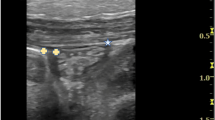Abstract
Laparoscopic candidates with abdominal scars may have adhesions that result in visceral injury during trocar insertion. The purpose of this study was to evaluate the use of preoperative ultrasound mapping of abdominal wall adhesions, to provide safe initial laparoscopic access, and to guide the placement of subsequent trocars, facilitating adhesolysis when necessary. Thirty consecutive patients with previous abdominal surgery who were scheduled for laparoscopy underwent a preoperative ultrasonic examination of the abdominal wall using a 7-MHz linear ultrasound probe. Spontaneous viscera slide was measured during longitudinal scanning (normal=2–5 cm) and induced viscera slide was evaluated during longitudinal and transverse scanning (normal=1 cm or more) over the existing abdominal scar, the peri-umbilical region, and the remaining abdominal quadrants. Sixteen (53%) of 30 patients had adhesions under their scar and only four patients (25%) had umbilical adhesions. The 12 patients without umbilical adhesions all had successful closed cannulation while open cannulation at alternate sites was successful in the four individuals with umbilical adhesions. Blind umbilical needle cannulation was successfully done in all of the remaining 14 patients (47%) without visceral injury, including three patients (21%) with upper abdominal scars who were adhesion-free elsewhere. No adhesions were encountered that had not been preoperatively predicted by ultrasound. We conclude that examination of the abdominal wall with spontaneous and induced viscera slide, using ultrasound scanning, can reliably detect intraabdominal adhesions. The examination is best done on a highly selective basis by the operating surgeon to guide the location for initial trocar insertion and determine the type of abdominal wall cannulation in those individuals with previous abdominal scars.
Similar content being viewed by others
References
Berci G, Cusheri A (1986) Creation of a pneumoperitoneum and trocar insertion. In: Berci G, Cushieri A (eds) Practical laparoscopy. Bailliere Tindall, London, pp 44–65
Borten M (1986) Laparoscopic complications. BC Decker, Toronto, pp 285–295
Chi IC, Feldblum PJ, Balogh SA (1983) Previous abdominal surgery as a risk factor in interval laparoscopic sterilization. Am J Obstet Gynecol 145: 841–846
Cushieri A, Berci G (1990) Instrumentation and basic operative techniques for laparoscopic surgery. In: Cushieri A, Berci G (eds) Laparoscopic biliary surgery. Blackwell Scientific, London, pp 15–37
Hasson HM (1974) Open laparoscopy. A report of 150 cases. J Reprod Med 12: 234–238
Hasson HM (1978) Open laparoscopy vs. closed laparoscopy. A comparison of complication rates. Adv Plann Parent 13: 41–50
Kodama I, Loiacono LA, Sigel B, Machi J, Golub RM, Parsons RE, Justin J, Zaren HA, Sachdeva AK (1992) Ultrasonic detection of viscera slide as an indicator of abdominal wall adhesions. J Clin Ultrasound 20: 375–380
Marin G, Bergama S, Miola E, et al. (1987) Prelaparoscopic echography used to detect abdominal adhesions. Endoscopy 19: 147–150
Mintz M (1977) Risks and prophylaxis in laparoscopy. A survey of 100,000 cases. J Reprod Med 18: 269–272
Author information
Authors and Affiliations
Rights and permissions
About this article
Cite this article
Caprini, J.A., Arcelus, J.A., Swanson, J. et al. The ultrasonic localization of abdominal wall adhesions. Surg Endosc 9, 283–285 (1995). https://doi.org/10.1007/BF00187769
Received:
Accepted:
Issue Date:
DOI: https://doi.org/10.1007/BF00187769




